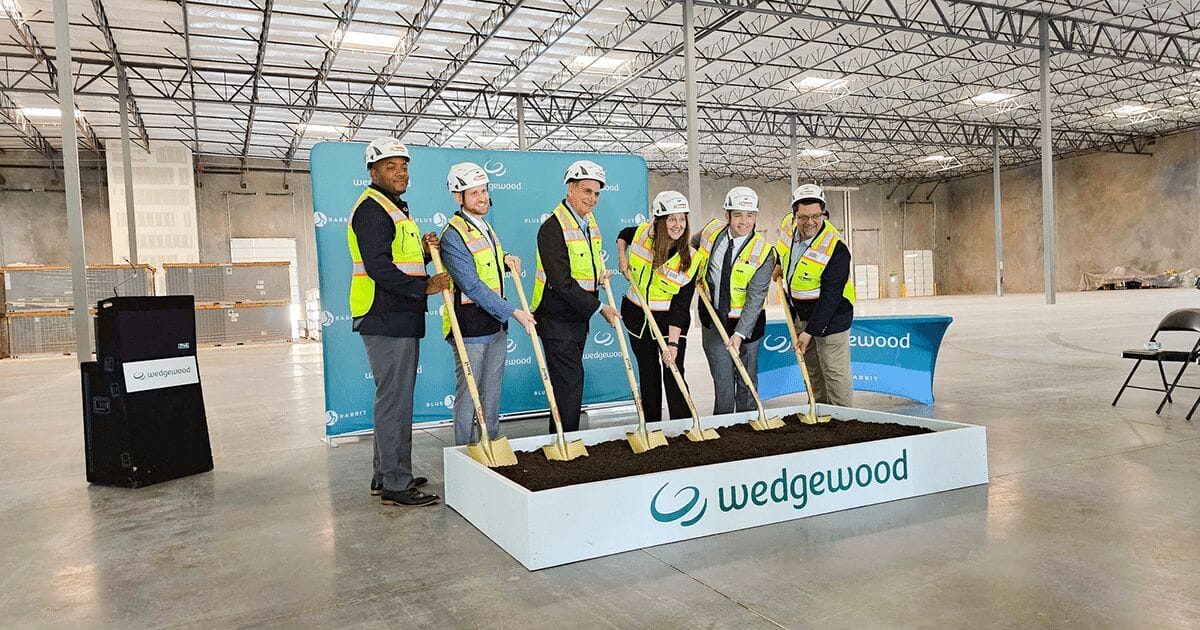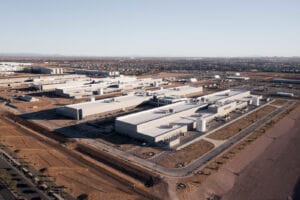Arizona mule deer can stand within 10 to 20 minutes after being born and double their weight in two weeks — that’s some rapid growth! While the Phoenix East Valley (Phoenix) technology ecosystem hasn’t matured in a matter of weeks, its expansion and evolution has been no less impressive. It’s clear that the region has and continues to put forth tremendous effort to attract national and global companies and entrepreneurial ventures in a wide range of tech-based markets.
FOOD NEWS: East Valley mayors cite Top 3 things on to-do lists for 2025
THINGS TO DO: Want more news like this? Get our free newsletter here
PHX East Valley technology ecosystem is born
Mule deer fawns are born of mothers, and the Phoenix East Valley tech ecosystem can point its origin story to early parent companies like Intel, which found its home in Chandler in the 1980s (and continues to expand). The company has designated two new Ocotillo Campus chip factories — Fab 52 and Fab 62 — to bolster U.S. semiconductor production.
In the 2000s, tech giants Apple and Google joined the ranks of Phoenix East Valley tech companies. Together, these heavy hitters (and others) positioned the region as a competitive technology hub, investing billions of dollars into the local economy and attracting companies of all sizes and specialities.
Semiconductor makes its mark
The forebears of technology economic development ultimately paved the way for what has now become a flourishing semiconductor hotspot in the East Valley. The 2020 news of Taiwan Semiconductor Manufacturing Company’s (TSMC) arrival to Greater Phoenix only increased the growth of this critical sector. The $65 billion investment will generate “6,000 direct manufacturing jobs, more than 20,000 accumulated unique construction jobs, and tens of thousands of indirect jobs,” according to the U.S. Department of Commerce.
Following TSMC, the semiconductor domino effect was in full swing for the PHX East Valley.
“Chandler has long been a semiconductor hub. With this investment, it’s really reinforcing Chandler’s global leadership position as an advanced manufacturing center,” says Micah Miranda, economic development director of City of Chandler. “Companies in the advanced manufacturing space are entering our market to serve Intel, TSMC and our other semiconductor companies such as Microchip and NXP.”
Mesa, too, has experienced an uptick of semiconductor growth, with the example of the South Korean semiconductor company KoMiCo to its portfolio in 2023.
“We just announced Magna,” says Jaye O’Donnell, economic development director for the City of Mesa, “and Infineon is a little known company in Mesa; they manufacture semiconductors and wafers.”
Semiconductor supply chain set
The submarket feeding semiconductor maturation has been a bonus addition to the East Valley tech landscape and its growth.
Cognite, a Norwegian industrial software company, identified the value proposition attached to the rapidly scaling semiconductor sector.
“Semiconductor design and manufacturing are essential elements of the AI value chain,” says Jeff Coulter, CFO of Cognite. “Working up front on how these come together with the silicon logic, data modeling software and driving value at the end customer can help create next generation hardware and software infrastructure.”
O’Donnell adds, “[In Mesa] we have Advanced Metals, FUJIFILM, Mitsubishi Gas Chemical Company and Benchmark Electronics. So we’re really starting to build out the semiconductor supply chain industries.”
Healthtech, biotech make their mark
Semiconductor growth, as significant as it has been, does not represent the entirety of the Phoenix East Valley tech ecosystem. Cognite, mentioned earlier, set to occupy 30,000 square feet of leased space at Tempe’s Hayden Ferry Lakeside III, is a prime example of a tech company that recognized the value of the East Valley’s diverse tech sector.
“Arizona’s growing tech ecosystem is the perfect location for Cognite,” Coulter says. “Cognite’s solutions make it possible for the largest industrial companies, with their diverse and expansive data sources, to contextualize their data to make AI possible, driving uptime, productivity and efficiencies across their enterprise.”
Industrial and advanced manufacturing play a pivotal role in attracting and supporting tech organizations.
“The town is already leveraging the momentum that LG Energy Solution has created by selecting Queen Creek for its new manufacturing facility,” says Doreen Cott, economic development director of the Town of Queen Creek.
Cott explains that Queen Creek has been highlighting the community’s investment in infrastructure that will benefit LG and the state at large, marketing the available workforce within a 45-minute commute (1.9 million people), and has been working with several supply chain projects that are part of the electric vehicle ecosystem.
“We’re promoting that there is a place in Queen Creek for a wide variety of technology businesses, depending on their needs, since we have brand new existing industrial space, small zoned-sites and mega sites,” she says.

In February, Wedgewood, the nation’s leading provider of high-quality compounded medications for animals and the parent company of the new veterinary online pharmacy platform, Blue Rabbit, celebrated the groundbreaking for its new state-of-the-art facility in Chandler. (Photo provided by Wedgewood)
Rise in healthtech
In Chandler, there has been a rise in healthtech — both manufacturing and in the technology required to support clinical trials.
“Wedgewood Pharmaceutical is a new pharmaceutical manufacturing facility —primarily within the animal science space — that will be coming online here in the next couple of years,” Miranda explains. “And that’s going to be out in the Airpark employment corridor.”
Additionally, Arizona Liver Health, in collaboration with Arizona Clinical Trials, has established the ACT Medical Park in Chandler. The state-of-the-art facility focuses on liver health and conducts clinical trials to advance medical research. Miranda explains how this project in particular contributes to the broader tech ecosystem by fostering innovation in medical research and healthcare delivery.
Mesa is also in the midst of a rise in healthtech and biotech. “We have Dexcom [a leader in continuous glucose monitoring technology],” O’Donnell says. “They brought their manufacturing over from San Diego in 2017, and they have since expanded.”
O’Donnell notes that other arrivals include Nucleus RadioPharma, a biotechnology company specializing in the development and manufacturing of radiopharmaceuticals; OptumRX, a pharmacy care services provider that opened a state-of-the-art home delivery pharmacy and Merz Aesthetics, a global aesthetics company, focusing on research and development in the field of aesthetic medicine.
The Town Gilbert continues to be a growing hub for biotechnology, life sciences, and healthcare, adding to an existing robust base in information and communications technology (ICT), aerospace and aviation and clean technology.
“[Biotechnology, life sciences and healthcare] growth over the last five years in Gilbert (49%) was almost double that of the state and is projected to grow by another 16% in the next five years,” says Dan Henderson, director of economic development of the Town of Gilbert. “There are over 2.2 million square feet of hospital and clinical research facilities, including Banner M.D. Anderson Cancer Center, the Ironwood Cancer Research Center, Mercy Gilbert Medical Center and Banner Gateway Medical Center.”
Gilbert has contributed more than 650,000 square feet of medical and healthcare development to the Phoenix East Valley within the last two years.
Nature and nurture
The mule deer in the Sonoran Desert have all they need — from mesquite leaves to prickly pear pads — to thrive in their environment. The same can be said for the technology ventures that make Phoenix their home. Within this region, companies benefit from a robust workforce fed in large part by the local K-12 and post-secondary education systems.
“Our team consistently hears from tech and other businesses that they selected Tempe for its location, access to an educated and available workforce, and the presence of Arizona State University (ASU),” says April Kroner, deputy economic development director for the City of Tempe.
In March of 2023, ASU’s Fulton School expanded to the ASU West Valley campus with the School of Integrated Engineering, bringing the number of Fulton Schools to eight, and by Fall 2023, exceeding enrollment to 31,000 students.
“Our Tempe location is ideal for taking advantage of local universities that have extensive programs aligned with Cognite’s technical areas of AI, large data models and machine learning,” Coulter says.
Many East Valley cities make concerted efforts to match the tech ecosystem with continuity of education, starting early. Cott explains that Queen Creek accomplishes this by working with the K-12 educational systems, career and technical education (CTE) programs and evolving key relationships with Chandler-Gilbert Community College (CGCC) and Central Arizona College (CAC).
“Gaining knowledge about the certification programs that are available to provide local residents the skills needed in key tech jobs in a condensed time frame is critical for companies needing to hire skilled employees,” Cott says.
In Gilbert, Park University, University of Arizona College of Nursing, ASU’s Polytechnic Campus and CGCC are not only bolstering Gilbert’s talent pipeline, they are fueling emerging technologies from educational institutions, strengthening STEM occupations and placing a strong focus on innovation and tech industries — all of which help lay the foundation for the community’s and greater East Valley region’s future.
And of the graduates of post-secondary institutions, Miranda adds, “They’re cranking out students who most importantly can critically think regardless of degree specialty. And that’s something all organizations need.”
United front
In addition to a skilled talent pool and educational foundation, the other essential component to perpetuating a healthy tech ecosystem is regional collaboration.
“I think we’re very collaborative and I think a lot of that stems from wanting to work together,” O’Donnell says, “because I learned from other economic developers in other communities and what someone does in Chandler or Scottsdale, we know it’s going to affect us too.”
Kroner concludes, “With the other major tech companies in the East Valley, we will continue to work with our regional and state partners such as the PHX East Valley Partnership, Greater Phoenix Economic Council and Arizona Commerce Authority to make sure we continue to offer a favorable and supportive business climate to retain the significant companies here, and to attract other businesses in the supply chain that are advantageous to bring into our ecosystem.”




